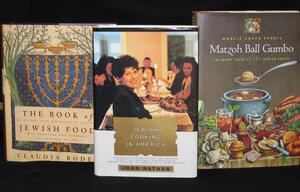Recipes are like a map. You can follow the path of a recipe to give you clues as to how Jews lived in different communities as they migrated. You can see which ingredients come from which places on our journeys and how changes to Jewish food culture have been made along the way. Taken together, recipes reflect the diversity of Jewish culture in different times and places.
Throughout history, Jews have continually migrated to new countries and new continents. Sometimes, Jews had to flee the dangers of anti-Semitism. At other times, Jews moved in search of economic opportunities. Whatever the cause of their migration, once Jews settled in their new homes, they interacted with their neighbors and picked up aspects of local culture, including foods and ways of cooking. They often adapted new local recipes to meet kosher standards and religious requirements, such as the prohibition against cooking on Shabbat. Also, they brought with them recipes and ingredients, and introduced these ingredients and cooking styles to their new societies.
Studying the history of food can tell us a lot about the extent to which Jews interacted with those around them in various places and times. For example, in Morocco today, although the Jewish community has dwindled, Jewish cooking is considered one of the country's main culinary traditions. It reminds eaters of the importance of Jews to Morocco's history every day. In another example, in modern day Spain, people generally cook with oil rather than pork fat or butter because of the historical Jewish presence in the region. Jews didn't cook with pork fat since it was not kosher, and they didn't cook meat in butter for similar reasons, so they fried foods in oil, a neutral kosher substance.
Women, traditionally the preparers of food, are the ones who have been responsible for figuring out how to find substitutes for ingredients no longer available in a new place, incorporate new local ingredients and adapt them to the Jewish styles of cooking they brought with them. For example, in the cookbook Matzah Ball Gumbo, author Marcie Cohen Ferris tells us how Jewish women of Louisiana adopted Creole and Cajun cuisines (which come from French and African culture) to create the Creole Matzah ball. Similarly, according to Joan Nathan in Jewish Cooking in America, "While Jews in Burlington, Vermont, ate potato latkes with maple syrup, Californians preferred theirs with local goat cheese." The latke has remained constant as a Jewish food, but it is served with different toppings in different regions of America.
Women often are the transmitters of culture, handing down traditions from generation to generation. Before the days of standardized measuring cups and written recipes, young girls watched as their mothers and grandmothers scooped handfuls of flour and pinches of spices or jarfuls of water or oil in their kitchen wizardry. Cooking was one way that women expressed their creativity.
Batsheva Levy Salzman learned how to cook Sukkot pumpkin soup from her mother as a girl growing up in Morocco. When she moved to Israel and then America, she brought the recipe with her in her head, and converted it into a recipe for Thanksgiving. Sukkot is a Jewish holiday, traditionally a fall harvest festival, when squash and gourd foods are eaten. In America, pumpkins (often in the form of pie) are a traditional Thanksgiving food. In addition to these similarities, both holidays offer chances to express gratitude to God for the good harvest. Switching a food from one holiday to the other helps highlight the relationship between the two holidays.
Women of other cultures have brought their treasures to Jewish cooking as well. In the southern United States, Ferris tells us how African-American women, working as domestic workers for Jewish families, blended their traditional dishes with Jewish foods to create such recipes as barbecued brisket, Sabbath fried chicken, collard greens with gribbenes (fried chicken fat and skins), sweet potato kugel, and lox and grits.
Jews have lived everywhere in the world. We can find Jewish styles of cooking in South America, Europe, Africa, and China. Including Jewish recipes from around the world and from different regions of the U.S. on our menus and in our consciousness can help make our communities more open and welcoming to people of Jewish and non-Jewish backgrounds alike.



